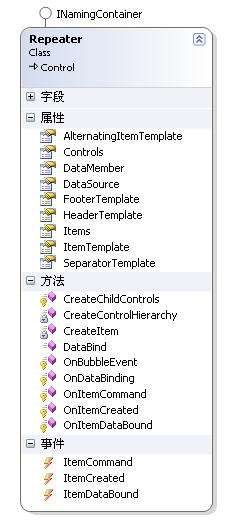asp.net控件开发基础(18)
本篇继续上篇的讨论,可能大家已经在使用asp.net2.0了,DataSource属性不再使用,而是跟数据源控件搭配使用.现在讨论的绑定技术都是基于1.1版本,先熟悉一下,本质上是一样的,这样一步步的学习.对以后绝对有帮助.因为当你使用数据源控件,只需要设置一个DataSourceID,方便的同时你是否知道数据源控件帮你做了什么事情,如果你想觉的够用了,可以不用了解,但我相信你一定会有需求。上篇最后说过了,讨论还刚刚开始,我们大致把核心的方法都写出来了.下面我们继续。
一.控件对比
我们可以使用上篇制作的TemplatedList控件跟内置控件做一下对比异同。在2.0未到来的时候,我们只有Repeater,DataList,DataGrid,现在我们也根据这三个控件进行讨论,下面把TemplatedList与DataList进行对比
(1)布局样式没DataList多...
(2)模板没DataList多...
(3)TemplatedList没ItemCollection
(4)TemplatedList没有预定义Command事件(如EditCommand,UpdateCommand等)
或者还有更多的,上面的都是次要的,布局上面我们可以改善,我们也可以添加ItemCollection,也可以预定义Command事件,但发现TemplatedList跟内置的绑定控件有几个跟数据操作严重的不同点
(1)DataSource属性类型不同 IEnumerable和Object
为什么要将其类型设置为Object呢?
IEnumerable支持Array,ArrayList等返回类型,但却不支持DataSet类型,这是一个很严重的问题,设置其类型为Object,可以让控件支持更广泛的数据源(当然也要根据需求)这个是本次讨论的重点
(2)DataMember
其用于指定数据源的特定表,由于DataSet的介入,其可能含有多个表,所以也就有了这个属性,否则的话就不需要他
(3)DataKeyField键字段
由于预定义Command事件的介入,实现对数据的操作,DataKeyField用于帮助数据特定记录的操作
二.确定目标
根据上面的对比,我们已经知道接下来要做什么了,要让控件DataSouce属性支持更多的数据源(只要还是DataSet)
本次的demo我们将要模仿Repeater来制作,为什么不用TemplatedList?因为这样我们可以对更多控件的实现更加的熟悉,这样在使用内置控件的时候,你将明白的更透彻.此处的demo来自Building ASP.NET Server Controls书中的例子
Repeater与TemplatedList的异同
不同点
大家都知道Repeater可以灵活的进行布局,所以去掉了模板样式属性,我们为其添加了多个模板属性,Repeater控件没有预定义Command事件,所以不需要DataKeyField属性.还为Repeater定义了TemplatedListmy没有的ItemCollection集合,当然也可以为TemplatedList添加这个集合最大的不同。Repeater支持DataSet,TemplatedList不支持。
相同点
都是数据绑定控件,所以里面很多的实现方法几乎相同,如果你看过TemplatedList的实现,再看Repeater的代码,基本没有难度,Repeater的实现比TemplatedList还要简单。
好了,下面我们开始吧.
三.实现
1.为数据控件做好准备
几乎跟上篇一样,所以不再介绍
2.编写Repeater
(1)定义成员属性和事件
/// <summary>
/// 绑定的列表的数据源
/// </summary>
[Category("Data"), Description("绑定的列表的数据源"),
DesignerSerializationVisibility(DesignerSerializationVisibility.Hidden),
DefaultValue(null), Bindable(true)]
public object DataSource
{
get
{
return dataSource;
}
set
{
if ((value is IEnumerable) || (value is IListSource) || (value == null))
dataSource = value;
else
throw new Exception("错误的数据源类型");
}
}
/// <summary>
/// 当数据绑定到列表数据源时要提取的数据成员
/// </summary>
[Category("Data"), Description("当数据绑定到列表数据源时要提取的数据成员")]
public virtual string DataMember
{
get
{
object member = ViewState["DataMember"];
if (member == null)
return string.Empty;
else
return (string)member;
}
set
{
ViewState["DataMember"] = value;
}
}
(2)关键实现
1.因为Repeater模板不具有样式属性,所以去掉了PrepareControlHierarchy方法。
2.由于不涉及到复杂的样式属性,所以不必重载视图状态管理的三个方法。
这两点就可以让控件减少很多代码的编写
3.CreateControlHierarchy方法和CreateItem方法
Repeater模板的实现方法和TemplatedList稍有不同,但变化不大,应该容易理解.看下面代码
/// 创建控件各种项
/// </summary>
/// <param name="itemIndex"></param>
/// <param name="itemType"></param>
/// <param name="dataBind"></param>
/// <param name="dataItem"></param>
/// <returns></returns>
private RepeaterItem CreateItem(int itemIndex, ListItemType itemType, bool dataBind, object dataItem)
{
ITemplate selectedTemplate;
//根据不同类型创建不同项
switch (itemType)
{
case ListItemType.Header:
selectedTemplate = headerTemplate;
break;
case ListItemType.Item:
selectedTemplate = itemTemplate;
break;
case ListItemType.AlternatingItem:
selectedTemplate = alternatingItemTemplate;
break;
case ListItemType.Separator:
selectedTemplate = separatorTemplate;
break;
case ListItemType.Footer:
selectedTemplate = footerTemplate;
break;
default:
selectedTemplate = null;
break;
}
if ((itemType == ListItemType.AlternatingItem) &&
(alternatingItemTemplate == null))
{
selectedTemplate = itemTemplate;
itemType = ListItemType.Item;
}
RepeaterItem item = new RepeaterItem(itemIndex, itemType, dataItem);
if (selectedTemplate != null)
{
selectedTemplate.InstantiateIn(item);
}
OnItemCreated(new RepeaterItemEventArgs(item));
Controls.Add(item);
if (dataBind)
{
item.DataBind();
OnItemDataBound(new RepeaterItemEventArgs(item));
}
return item;
}
private ArrayList items = null;
private void CreateControlHierarchy(bool useDataSource)
{
items = new ArrayList();
IEnumerable ds = null;
if (HeaderTemplate != null)
{
RepeaterItem header = CreateItem(-1, ListItemType.Header, false, null);
}
int count = -1;
if (useDataSource)
{
//解析DataSource
ds = (IEnumerable)DataSourceHelper.ResolveDataSource(DataSource,
DataMember);
}
else
{
count = (int)ViewState["ItemCount"];
if (count != -1)
{
ds = new DummyDataSource(count);
}
}
if (ds != null)
{
int index = 0;
count = 0;
RepeaterItem item;
ListItemType itemType = ListItemType.Item;
foreach (object dataItem in (IEnumerable)ds)
{
if (index != 0)
{
RepeaterItem separator = CreateItem(-1, ListItemType.Separator, false, null);
}
item = CreateItem(index, itemType, useDataSource, dataItem);
items.Add(item);
index++;
count++;
if (itemType == ListItemType.Item)
itemType = ListItemType.AlternatingItem;
else
itemType = ListItemType.Item;
}
}
if (FooterTemplate != null)
{
RepeaterItem footer = CreateItem(-1, ListItemType.Footer, false, null);
}
if (useDataSource)
{
ViewState["ItemCount"] = ((ds != null) ? count : -1);
}
}
 if (useDataSource)
if (useDataSource) {
{ //解析DataSource
//解析DataSource ds = (IEnumerable)DataSourceHelper.ResolveDataSource(DataSource,
ds = (IEnumerable)DataSourceHelper.ResolveDataSource(DataSource, DataMember);
DataMember); }
}
// <summary>
/// 一个解析DataSource的辅助类
/// </summary>
public class DataSourceHelper
{
public static object ResolveDataSource(object dataSource, string dataMember)
{
如果数据源为空,则返回空值
如果数据源不为空,且为IEnumerable类型,则返回IEnumerable
如果数据源不为空,且为IListSource类型,则返回IListSource
return null;
}
}
这个辅助类判断太多,刚看会看晕掉的,所以在if判断这里把代码折叠起来,有助于理解。这里有几个类可能没见过,我们把关键用到的类一一列出来,希望大家查查MSDN
1.IListSource 向对象提供返回可以绑定到数据源列表的功能
2.ITypedList 提供发现可绑定列表架构的功能,其中可用于绑定的属性不同于要绑定到的对象的公共属性
3.PropertyDescriptor 提供类上的属性的抽象化
4.PropertyDescriptorCollection 表示 PropertyDescriptor 对象的集合
下面开始
(1).首先如果传入的数据源类型是IEnumerable的话,很好,可以直接返回
 if (dataSource is IEnumerable)
if (dataSource is IEnumerable) {
{ return (IEnumerable)dataSource;
return (IEnumerable)dataSource; }
}
虽然传入的类型非IEnumerable,如DataSet类实现了IListSource接口,其目的就是使用此接口的GetList方法返回一个IList(IList继承IEnumerable,可以进行数据绑定),大家可以参考MSDN的原话
 IList list = null;
IList list = null; IListSource listSource = (IListSource)dataSource;
IListSource listSource = (IListSource)dataSource; list = listSource.GetList();
list = listSource.GetList();
DataViewSettingCollection是什么呢?表示DataTable的DataViewSetting的集合
DataViewSetting是什么呢?表示从 DataViewManager 创建的 DataView 的 的默认设置
上面的我们不熟,DataView大家应该熟悉,其可以对数据进行排序,过滤等。DataViewManager为一个默认的DataView设置集合,不知这样是否可以理解的好些。我们的目的则是将其转化到IEnumerable类型,继续DataViewManager实现了ITypedList接口。我们需要将DataViewManager(即list)转化到ITypedList ,为什么?ITypedList的GetItemProperties方法将帮助你获取DataView数据绑定的数据对象,而非DataView本身属性。
ITypedList的GetItemProperties方法绑定数据的每项属性的PropertyDescriptorCollection集合,PropertyDescriptorCollection表示PropertyDescriptor集合,PropertyDescriptor这个类很好玩,等同于属性的说明书,即用了.net的反射技术,大家可以尝试一下,其实以前也用过这个类.下面来看代码片段
这样我们就得到了一个DataTablePropertyDescriptor属性描述符,继续
 //提供发现可绑定列表架构的功能,其中可用于绑定的属性不同于要绑定到的对象的公共属性
//提供发现可绑定列表架构的功能,其中可用于绑定的属性不同于要绑定到的对象的公共属性 ITypedList typedList = (ITypedList)list;
ITypedList typedList = (ITypedList)list; //返回表示用于绑定数据的每项上属性集合
//返回表示用于绑定数据的每项上属性集合 PropertyDescriptor[] pd = new PropertyDescriptor[0];
PropertyDescriptor[] pd = new PropertyDescriptor[0]; PropertyDescriptorCollection propDescCol =
PropertyDescriptorCollection propDescCol = typedList.GetItemProperties(pd); //was (null)
typedList.GetItemProperties(pd); //was (null) //如果属性说明符数目为0
//如果属性说明符数目为0 if (propDescCol.Count == 0)
if (propDescCol.Count == 0) throw new Exception("ListSource without DataMembers");
throw new Exception("ListSource without DataMembers");
 PropertyDescriptorCollection propDescCol =
PropertyDescriptorCollection propDescCol = typedList.GetItemProperties(null); //was (null)
typedList.GetItemProperties(null); //was (null)
//获取属性描述符
//若不指定dataMember属性则获取默认数据成员
if ((dataMember == null) || (dataMember.Length < 1))
{
propDesc = propDescCol[0];
}
else
//尝试在属性集合中寻找数据成员
propDesc = propDescCol.Find(dataMember, true);
#endregion
if (propDesc == null)
throw new Exception("ListSource missing DataMember");
 object listitem = list[0];
object listitem = list[0];
 //获取组件属性当前值
//获取组件属性当前值 object member = propDesc.GetValue(listitem);
object member = propDesc.GetValue(listitem);
 if ((member == null) || !(member is IEnumerable))
if ((member == null) || !(member is IEnumerable)) throw new Exception("ListSource missing DataMember");
throw new Exception("ListSource missing DataMember");
 return (IEnumerable)member;
return (IEnumerable)member;
此处实现原理:
DataViewManager会在其DataSet中的DataTableCollection中搜索datamember的值进行匹配,看下图,做这么多事情,我们一直在转换
注:GetValue用法
 PropertyDescriptorCollection properties = TypeDescriptor.GetProperties(Button1);
PropertyDescriptorCollection properties = TypeDescriptor.GetProperties(Button1); PropertyDescriptor pd = properties.Find("Text", false);
PropertyDescriptor pd = properties.Find("Text", false); Button b=new Button();
Button b=new Button(); b.Text = "cc";
b.Text = "cc"; object c=pd.GetValue(b);
object c=pd.GetValue(b); Response.Write(c);
Response.Write(c); //return cc
//return cc用GetValue方法获取listitem属性值,此属性跟datamember匹配,最后member得到的是一个DataView,DataView实现了IEnumerable,现在终于可以转换了。到此为止就结束了,现在你可以成功的传入DataSet了。
下一篇:asp.net控件开发基础(19)







